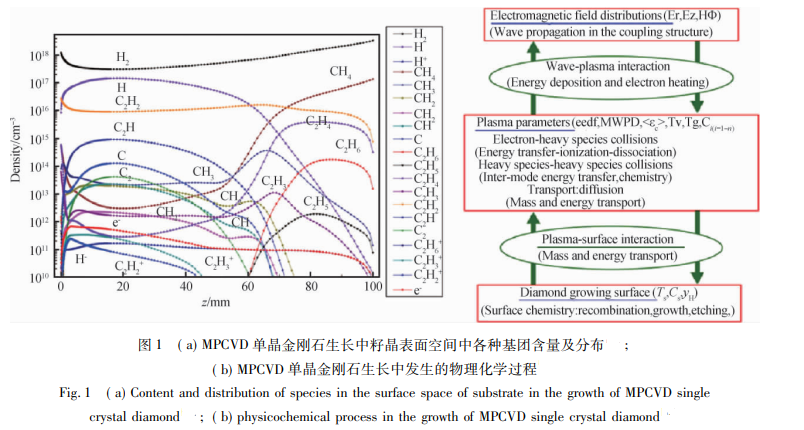Since Kamo et al.first reported the preparation of homoepitaxial single crystal diamond in 1988, how to improve the growth rate of single crystal diamond has become one of the hot issues studied by scholars. In the early MPCVD single crystal diamond growth process, due to the technical conditions at that time and people 's understanding of its mechanism, the pressure used in the growth was generally 20 ~ 100 Torr, the rate density was less than 5 W / cm3, and the methane ratio was only about 1 %, so the growth rate was usually less than 1 μm / h. With the gradual understanding of the growth mechanism of MPCVD single crystal diamond and the progress of related growth equipment technology, various methods to improve the growth rate of single crystal diamond homoepitaxial growth emerge in endlessly, and the growth rate is also increased from the initial several microns per hour to more than one hundred microns per hour. This section will first briefly introduce the mechanism of MPCVD diamond growth, and then summarize the methods and achievements commonly used by researchers in the field of high-speed single crystal diamond growth in recent years.
Introduction to the growth mechanism of single crystal diamond by MPCVDThe growth of single crystal diamond by microwave plasma chemical vapor deposition can be simply described as the following process, that is, microwave forms a concentrated electric field in the area above the sample stage after resonance through a specially designed resonant cavity, dissociates hydrogen, methane and other raw gas to form atomic hydrogen and a series of carbon-containing precursor plasma, and then grows diamond on the surface of seed crystal cooled to a certain temperature. However, in fact, this microscopic process is very complicated. There are at least more than 20 different groups composed of free carbon atoms and hydrogen atoms in the plasma excited by two raw gases of hydrogen and methane. The content and distribution of various groups in the seed surface space during the growth of MPCVD single crystal diamond can be determined by optical emission spectroscopy ( Fig.1 ).

In the theoretical model of MPCVD diamond growth, the model proposed by Harris and Goodwin is relatively simple and adopted by most scholars. In its model, only atomic H and methyl CH3 groups are actually involved in diamond growth, and the following five-step reaction is carried out :

The first step is the formation of the active site C * 4 on the surface of the seed crystal. At the same time, this active site can again combine with the atom H to form a carbon-hydrogen bond, that is, reaction 2. Reaction 1 and reaction 2 define the reaction rate ratio k1 / ( k1 + h2 ), which is only related to temperature. The latter three reactions describe the process by which this active site binds methyl groups and absorbs carbon atoms into the diamond lattice. Through the description of this reaction process, the growth rate formula of MPCVD single crystal diamond { 100 ) crystal plane can be obtained :

It can be seen from the growth process of MPCVD single crystal diamond that increasing the concentration of atomic H and methyl CH3 is one of the most direct methods to increase the growth rate of single crystal. Through the research and experiments of scholars, it is shown that atoms play an extremely important role in the growth of CVD diamond. It can participate in the process of generating hydrocarbon groups, forming surface active sites and inhibiting the formation of non-diamond phases. Therefore, some researchers attribute how to quickly prepare high-quality single crystal diamond to how to produce as many effective atoms as possible. Understanding the growth process and mechanism of MPCVD single crystal diamond will help researchers to better find ways and means to improve the growth rate.
CSMH focuses on the research and production of diamond wafers, and currently has diamond wafer, diamond heat sink , GaN on diamond ,AIN on diamond and other products, providing diamond thermal management solutions for our customers.
 闽ICP备2021005558号-1
闽ICP备2021005558号-1Leave A Message